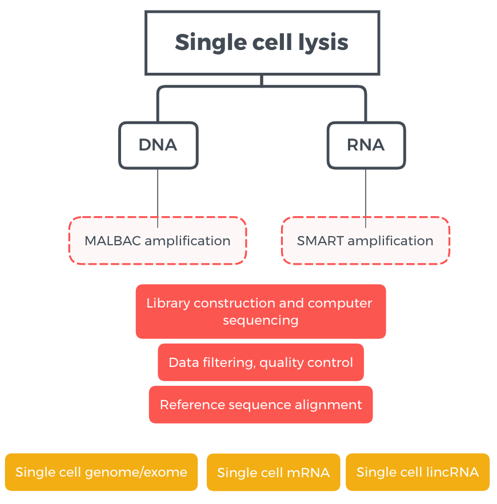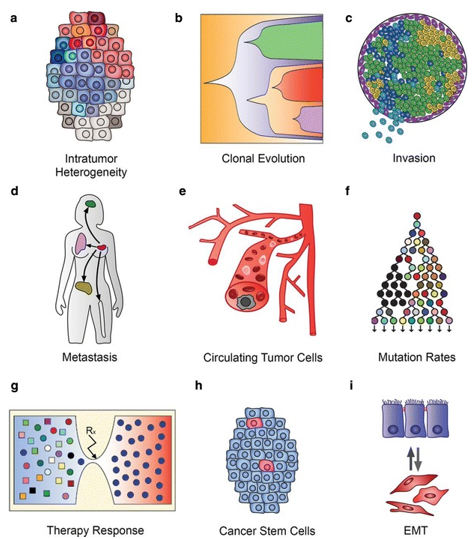Cancer is an important cause of death in the world. At present, due to the lack of understanding of the molecular mechanism of carcinogenesis and tumor progression, the clinical treatment of most cancer patients has not been completely solved. Single-cell sequencing includes a set of powerful and comprehensive techniques that provide an in-depth understanding of these unknown objects. Advances in genomic technology have enabled people to detect mutations and gene expression profiles of cancer cells at the single-cell level. Single cell sequencing can make a comprehensive and accurate analysis of cancer cell genomes, transcriptome and epigenome. The use of single cell sequencing analysis of cancer cells can directly see the high heterogeneity and random changes in the cancer cell population, new driver mutations and complex clonal evolution mechanisms, as well as the identification of new biomarkers. Single cell sequencing methods include single cell isolation, whole genome and transcriptome amplification, epigenome analysis, multidimensional sequencing and next generation sequencing and analysis.Because mutagenesis, gene regulation and gene modification occur inherently at the single cell level, single cell sequencing will achieve highly accurate characterization of carcinogenic molecules. This will lead to the identification of new biomarkers and drug targets, which in turn promotes the diagnosis, monitoring and treatment of cancer.
Applications of Single-cell Sequencing in Cancer Research
- Resolving intratumor heterogeneity;
- Investigating clonal evolution in primary tumors;
- Studying invasion in early stage cancers;
- Tracing metastatic dissemination;
- Genomic profiling of circulating tumor cells;
- Investigating mutation rates and mutator phenotypes;
- Understanding evolution of resistance to therapy;
- Defining cancer stem cells and cell hierarchies;
- Studying cell plasticity and the epithelial-to mesenchymal transition.
Figure1. Applications of single-cell sequencing in cancer research (Ellsworth D L, et al, 2017)
Our Solution
Single cell sequencing methods include single cell isolation, whole genome and transcriptome amplification, epigenome analysis, multidimensional sequencing and next generation sequencing and analysis.Because mutagenesis, gene regulation and gene modification occur inherently at the single cell level, single cell sequencing will achieve highly accurate characterization of carcinogenic molecules. This will lead to the identification of new biomarkers and drug targets, which in turn promotes the diagnosis, monitoring and treatment of cancer.
Experimental Process

| DNA Analysis | Overall quality assessment; Variation annotation.Susceptibility gene screening; Prediction of tumor-driven mutation; High frequency mutation gene analysis |
| mRNA Analysis | Overall quality assessment; TSS and TTS locus statistics; Variable shear analysis; Differential expression analysis; Differential enrichment analysis |
| lincRNA Analysis | Overall quality assessment; LincRNA splicing and screening; LincRNA conservative analysis |
Sample Requirement
(1) DNA level: rare samples such as single cell, single chromosome, a small number of cells or genomic DNA of 0.5 pg.
(2) RNA level: RNA containing PolyA tail in single cell, trace cells (several to thousands) and trace Total RNA (10 pg-10ng).
Amplification technology: MALBAC/SMART amplification technology.
Sequencing strategy: Illumina HiSeq platform; PE150.
Sequencing depth: personalized customization of the sequencing depth you need.
Project duration: 46 days (tumor single cell genome / exon: amplification 10 days, database sequencing analysis 36 days).
50 days (tumor single cell transcription group: amplification for 10 days, database sequencing for 40 days).
70 days (tumor single cell lincRNA: amplification for 10 days, database sequencing for 60 days)
Creative Proteomics leads a rich team that uses the most stringent data quality control standards and internationally recognized genome-wide amplification technology to analyze tumor single cell sequencing for your customized information, helping you effectively screen and systematically analyze the heterogeneity of these different cancer cells and cancer cells.
Reference
1. Ellsworth D L, Blackburn H L, Shriver C D, et al. Single-cell sequencing and tumorigenesis: improved understanding of tumor evolution and metastasis. Clinical and translational medicine, 2017, 6(1): 15.
* For Research Use Only. Not for use in the treatment or diagnosis of disease.
Related Services:



